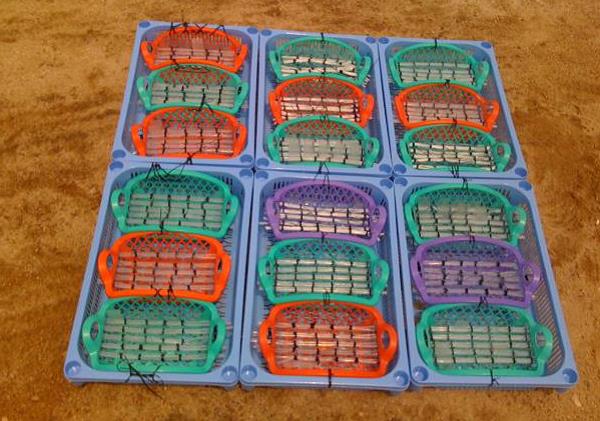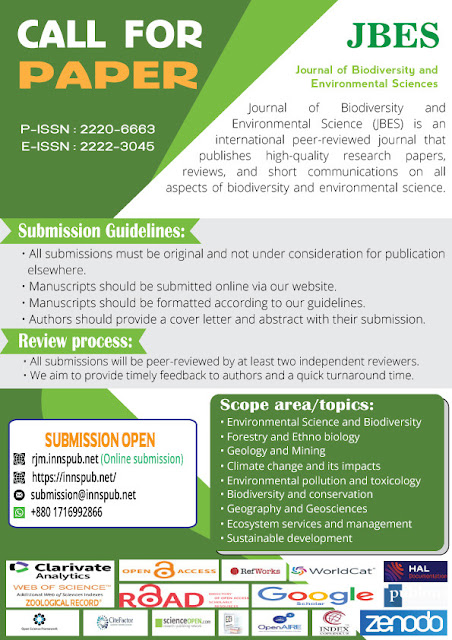Dike Henry Ogbuagu, Chidiogo Grace Okoli,
Enos Ihediohamma Emereibeole, Ikechukwu Chimezie Anyanwu, Osinachi Onuoha,
Nkiruka Onyekachi Ubah, Chibueze Oscar Ndugbu, Obinna N. Okoroama, Arthur
Okafor, Edu Ewa, Rex Ossai, and Favour Ukah, from the different institute of
the Nigeria. wrote a research article about, Trace Metals in Otamiri
River Biofilms: Owerri, Nigeria. entitled, Trace metals accumulation in
biofilms of the upper and middle reaches of Otamiri river in Owerri, Nigeria. This
research paper published by the Journal of Biodiversity and Environmental
Sciences (JBES). an open access scholarly research journal on Biodiversity.
under the affiliation of the International Network For Natural
Sciences | NNSpub. an open access multidisciplinary research journal
publisher.
Abstract
This study utilized
biofilms as model in ecotoxicology to estimate pollutant loading of a natural
water body. Water samples were collected from six sampling locations sited
between the upper and middle courses of the Otamiri River in the southeastern
city of Owerri, Nigeria and fixed with conc. HNO3. Biofilms were grown in
microcosms housing serially arranged sterile glass slides at the sampling
locations, harvested after 1, 2 and 3 weeks, minced in sterile sample bottles
with distilled water and fixed with conc. HNO3. Natural biofilms were also
collected from submerged surfaces and fixed. Pb, Cu and Cd contents were
determined in samples with atomic absorption spectrophotometer. The studentized
t-test was used to compare trace metals levels in water column and biofilms,
while single factor ANOVA was used to determine spatial homogeneity in mean
variance. Mean Pb concentrations ranged from 1.5950-3.2900 (2.4303 ± 0.0835)
mg/kg, Cu from 4.2934-7.5020 (5.6212 ± 0.1938) mg/kg and Cd from 0.0308-1.0559
(0.2082 ± 0.0005) mg/kg in the slide biofilms. However, they ranged from
0.0017-0.0267 (0.0150 ± 0.0003), 0.0333-0.6067 (0.2047 ± 0.0929) mg/L and
totally undetected, respectively in water columns. Trace metals levels in slide
and natural biofilms differed very markedly from those in water column (sig.
t-values = 0.000, each), even as levels in slide and natural biofilms did not
(sig. t-value = 0.747) at P<0.05. Pb and Cu concentrations increased from
location 1 to 6 in both water columns and biofilms, even as there was
homogeneity in spatial mean variances in slide [F(1.1458)<Fcrit(4.1300)] and
natural biofilms concentrations [F(1.2812)<Fcrit(4.1300)] at P<0.05.
Although mean Pb and Cu levels were below regulatory limits and Cd undetected
in water columns, their average concentration exceedances were between 32 and
70 times higher in the biofilms. Results question the assignment of water
potable based on regulatory standards alone.
Read more : Fungal Pathogensin Early Maturing Mango Varieties: Senegal Study | InformativeBD
Introduction
Biofilms are consortium
of microorganisms which form on solid surfaces in aqueous or wet environments
(Costerton et al. 1994). They could be found in surface and ground waters, in
drinking water piping and wastewater treatment plants, and on other technical
equipment such as in the medical field (Wanner and Bauchrowitz, 2006). Biofilms
execute a niche and so, interact strongly with their environment; are greatly
affected by, as well as in return, affect the physical and chemical conditions
in their enmeshing habitats.
Biofilms prefer to live in sessile communities (Flemming and Wingender, 2001) and include bacteria, algae, amoebas, ciliates and fungi in a great variety of compositions. Sunlight favours the growth of photoautotrophic components of biofilms such as algae and cyanobacteria and they conduct photosynthesis and thus, build up their biomass from inorganic substances. By this function therefore, these autotrophs are primal species in the trophic chain. However, in the absence of sunlight, biofilms are formed mostly by heterotrophic bacteria, which degrade organic substances, with the less frequent chemoautotrophic bacteria which utilize inorganic substances (Wanner and Bauchrowitz, 2006). In streams, algae-dominant autotrophic biofilms are mostly found on the riverbed and bacterial-dominant heterotrophic biofilms are found in the pore systems under the river bed (Lock, 1993). As biomass producers and decomposers therefore, biofilms are important components in the trophic web.
In biofilms,
microorganisms are embedded in a slimy matrix which consists of extracellular
polymeric substances that are excreted by the organisms themselves. These
polymeric substances contain mainly high-molecular polysaccharides, proteins,
other carbohydrates (such as uronic acid), and small amounts of lipids and
nucleic acids (Wanner and Bauchrowitz, 2006).
As microorganisms,
biofilms have been particularly utilized as interesting models in ecotoxicology
to estimate the pollutant loading of natural water bodies and the hazard
potential of toxic substances. Their suitability for this purpose lies in the
central role they play in ecosystem metabolism and interaction with toxic
substances (Doering and Uehlinger, 2006), and on the other hand because, as
immobile biological elements, they accumulate pollutants over a long period of
time and may thus reveal chronic impacts (Wanner and Bauchrowitz, 2006).
Examples of such pollutants are the trace metals (Pb, Cd, Cu, Zn, Al, etc),
which are recalcitrant in the environment.
Though they are
important trace nutrients for water organisms, they can also be toxic at
elevated enough concentrations. An exploratory determination of levels of some
trace elements of the Otamiri River, one of the major river systems in Owerri,
the capital of Imo State, southeastern Nigeria revealed concentrations that
were below permissible limits by regulatory bodies, or even undetected by
analytical instruments used. However, even low metal concentrations can have
negative impacts on water organisms as well as local consumers, especially when
considered on the merit of their bioaccumulative potentials over a length of
time. Unfortunately, current researches in this area have been concentrated on
the comparison of concentrations with these regulatory standards as criteria
for assigning the river water potable. This current research therefore
investigated the accumulation potentials of some heavy metals of environmental
and public health importance (Cu, Pb and Cd) in consortium of resident biofilms
of Otamiri River against background levels in water columns. The study
approaches are as follows: - Determination of the concentrations of the trace
elements in slide and natural biofilms of the river - Comparison of the
concentrations of the trace elements in biofilms with water column levels as
well as regulatory standards, and - Determination of spatial variation in trace
metals concentrations in biofilms.
Reference
American Public Health
Association (APHA). 1998. Standard Methods for
the Examination of Water and Wastewater. 20th Edition,
APHAA/AWWA/WEF, Washington DC.
Federal Ministry of
Environment. 2001. National Guidelines and Standards for Water Quality in
Nigeria. Rishab Printing Press Production, p114.
Costerton JW,
Lewandowski Z, De Beer D, Caldwell D, Korber D, Jamese G. 1994. Minireview:
biofilms, the customized microniche. J. Bacteriol. 176, 2137-2142.
Wanner O, Bauchrowitz
M. 2006. Biofilms are ubiquitous. Eawag: Swiss Federal Inst. Aquat. Sci.
Technol. 60e, 4-7.
Flemming HC, Wingender
J. 2001. Biofilms-die bevorzugte Lebensform der Bakterien. Biologie in
unserer Zeit. 31, 169-180.
Lock MA. 1993. Attached
microbial communities in rivers. In: Aquat. Microbiol. (T.E. Ford, ed.).
Blackwell Scientific Publications, Oxford, p. 113-138.
Doering M, Uehlinger U.
2006. Biofilms in the Tagliamento. Eawag: Swiss Federal Inst. Aquat. Sci.
Technol. 60e, 11-13.
Meylan S, Sigg L, Behra
R. 2006. Metal accumulation in algal biofilms. Eawag: Swiss Federal Inst.
Aquat. Sci. Technol. 60e, 19-21.
Behra R, Ruperez W,
Wagner B, Kistler D, Sigg L, Navarro E, Robinson C. 2006. What effects do
metals have on algal biofilms? Eawag: Swiss Federal Inst. Aquat. Sci.
Technol. 60e, 16-18.
Onweremadu
EU, Akamigbo For, Igwe,CA. 2008. Soil
quality morphological index in relation to organic carbon content of soils in
southwestern Nigeria. Trends App. Sci. Res. 3(1), 76-82.
Victor S, AC-Chukwuocha
NB, Ogbuagu DH. 2011. Trace metals availability in soils of watershed in
relation to land use in Owerri, southeastern Nigeria. J. Sci. Sust. 3, 3-12.











%20in%20full.JPG)


0 comments:
Post a Comment